Editorial
Well, it appears that another year has passed while my attention was elsewhere. Looking at the December 2007 issue, I see that Australia was celebrating a change in government—for better or for worse, depending on your point of view—just as readers in the USA are this year. We here in south east Queensland were also facing dire water restrictions a year ago. That has eased considerably. The water supply is currently at 42% capacity, with 2% of that being dumped on us by two monster storms, virtually on top of each other, during November. The water recycling plants are finished too, as are pumping pipelines that form a so-called "water grid". These were intended to ensure that we don't face the prospect of running out of potable water again any time soon. But as the pressure is now off, our all too typical, self-serving politicians who are not in power are doing a good job of raising hysteria in the uneducated masses by saying that adding recycled water will lead to death, suffering, and berth defects! Quite simply, this is not correct, but that never stopped a polly before. Sadly, they have panicked enough citizens that the government, having built a magnificent, state of the art (not to mention very expensive), water recycling facility, are afraid to use it. So there it sits, doing nothing. Save me.
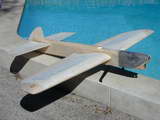 Very little machining done this month, except for a couple of stand-offs that secure the cowl of the Cardinal, which is now complete and almost ready for applying the finish. The covering is light weight tissue over 0.0015" thick mylar. The mylar is heat applied and shrunk, then the tissue is applied wet and attached with 80% thinned dope. Two coats seals it, so what you add in weight from the mylar, you more than make up for in the dope not used. The mylar was applied over the open areas only, so you get the normal bonding of the tissue to the solid, sheeted areas to give the usual torsional rigidity of the "traditional" finish. How well this will stand up in service, I don't know. My stunters usually last for thousands of flights, so longevity is a prime concern. The weight as seen here is a nice, low, 36 ounces. I should be able to bring the model in at just under 50 ounces, ready to fly, provided I don't get carried away with the finish.
Very little machining done this month, except for a couple of stand-offs that secure the cowl of the Cardinal, which is now complete and almost ready for applying the finish. The covering is light weight tissue over 0.0015" thick mylar. The mylar is heat applied and shrunk, then the tissue is applied wet and attached with 80% thinned dope. Two coats seals it, so what you add in weight from the mylar, you more than make up for in the dope not used. The mylar was applied over the open areas only, so you get the normal bonding of the tissue to the solid, sheeted areas to give the usual torsional rigidity of the "traditional" finish. How well this will stand up in service, I don't know. My stunters usually last for thousands of flights, so longevity is a prime concern. The weight as seen here is a nice, low, 36 ounces. I should be able to bring the model in at just under 50 ounces, ready to fly, provided I don't get carried away with the finish.
 This shot shows the major components before covering of the flying surfaces and final assembly. The fuselage construction follows an idea I saw on the PAMPA web site. Normally, the fuse is made in one piece, then a section above or below the wing cut away to allow the wing to be jiggled into place. This is fine, but somehow getting that cut-out bit to fit back in is just never quite successful and much bogging is required. There are a number of advantages to building the fuselage as two pieces. First, it's much easier to work on during construction, alignment with the wing is easier: first, tram the nose section to be centered and vertically aligned to the wing by placing it upside down on the bench; then tram the rear section to align centrally with the nose (using a string strung from nose center to tail center). The joint is at the wing high-point where cross braces for the bellcrank pivot shaft are required, so extra 1/16" ply reinforcement on the inside of the join distributes bellcrank loads into front and rear sections. Final engine choice was the rear exhaust Stalker 61 Ken sent out from England an age ago. By the way, the ends on the pushrod are CNC machined aluminum screwed onto titanium threaded inserts epoxied into a uni-directional carbon fibre rod. All these came from Ultra-Hobby. They are not R/C Kwik-links, which would be asking for a short life...
This shot shows the major components before covering of the flying surfaces and final assembly. The fuselage construction follows an idea I saw on the PAMPA web site. Normally, the fuse is made in one piece, then a section above or below the wing cut away to allow the wing to be jiggled into place. This is fine, but somehow getting that cut-out bit to fit back in is just never quite successful and much bogging is required. There are a number of advantages to building the fuselage as two pieces. First, it's much easier to work on during construction, alignment with the wing is easier: first, tram the nose section to be centered and vertically aligned to the wing by placing it upside down on the bench; then tram the rear section to align centrally with the nose (using a string strung from nose center to tail center). The joint is at the wing high-point where cross braces for the bellcrank pivot shaft are required, so extra 1/16" ply reinforcement on the inside of the join distributes bellcrank loads into front and rear sections. Final engine choice was the rear exhaust Stalker 61 Ken sent out from England an age ago. By the way, the ends on the pushrod are CNC machined aluminum screwed onto titanium threaded inserts epoxied into a uni-directional carbon fibre rod. All these came from Ultra-Hobby. They are not R/C Kwik-links, which would be asking for a short life...
 I hope you enjoy the December issue. Somehow it turned into quite a monster. As well as Part 2 of Gordon Cornell's engine development series, we have a long Adrian Duncan engine review, and the traditional December Free Plan set in the Members Download section. Also, as promised last month, there is the review of ICE version 1.7, Gordon's tool used to assist engine development. Add to that a show picture montage, some actual news, release of the second edition of the plan book, and updates to various older pages (see the Update Index in the Site Map menu). Sincere thanks go to all who joined the Members ranks last month and best wishes to everybody for the holiday season. See you next year...
I hope you enjoy the December issue. Somehow it turned into quite a monster. As well as Part 2 of Gordon Cornell's engine development series, we have a long Adrian Duncan engine review, and the traditional December Free Plan set in the Members Download section. Also, as promised last month, there is the review of ICE version 1.7, Gordon's tool used to assist engine development. Add to that a show picture montage, some actual news, release of the second edition of the plan book, and updates to various older pages (see the Update Index in the Site Map menu). Sincere thanks go to all who joined the Members ranks last month and best wishes to everybody for the holiday season. See you next year...
Nemett on the Web
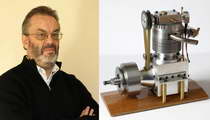
Malcolm Stride, author of Miniature Internal Combustion Engines, has launched a new web site called, appropriately, Nemett Engines. The site offers plans and details for Malcolm's engine designs. These started with the NE15-S bar-stock four-stroke, now called the Lynx. Next will be the twin cylinder NE15-IT Bobcat, then the NE7.5-S Jaguar. Many will be aware that Malcolm also writes the IC Topics column under the nom-de-plume "Nemett" in the 110 year old magazine, Model Engineer. In 1990, ME launched a sister publication called Model Engineers' Workshop to focus explicitly on, well, workshop tools and ideas. This left the ME to deal with the, well, err, models! All seems rather blindingly obvious when you write it down like that  . The magazines operated under separate editors from that time until just recently when David Clark was appointed editor for both ME and MEW. This means that some changes are in the wind and we will have to wait and see how this impacts the IC content dear to our hearts. British magazines are ruinously expensive "downunder" and should the IC content of the ME drop, I'll drop my subscription with a positive sigh of relief.
. The magazines operated under separate editors from that time until just recently when David Clark was appointed editor for both ME and MEW. This means that some changes are in the wind and we will have to wait and see how this impacts the IC content dear to our hearts. British magazines are ruinously expensive "downunder" and should the IC content of the ME drop, I'll drop my subscription with a positive sigh of relief.
Ascot '08

Speaking of Model Engineer, in years past, long-time MEN Member, John Downey, has kindly provided photos of model IC engines at the annual Model Engineer Exhibition. This year, the 101st for the show, his task was made difficult because of the little (little? hah!) email problem I caused myself. Fortunately for all of us, John persisted and resubmitted his photos, which have been assembled onto a new Ascot '08 page. Naturally this is just a small example of the fine craftsmanship on display at this popular exhibition, reflecting the focus of this web site. As well as the hugely popular live steam exhibits, there are always mind boggling displays of tools, miniature machines of all descriptions, boats, cars, and things which defy categorization; far too much for us to cover here, but worth mention never the less.
Model Engine Development Part 2
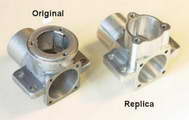
Gordon Cornell's Model Engine Development series which kicked off last month was very well received. The first part is an introduction to the process Gordon has devised in developing a design to reach full potential in the intended application. Although he uses his Super Fury to illustrate the techniques, the process described in the series is applicable to any two-stroke model engine. This month in Part Two, Gordon begins construction of a modern bar stock version of the Super Fury. This engine may be built with a rear rotary valve (RRV), like the original ED version, or with a rear drum induction valve. To complete the rear induction trifecta, Gordon is currently developing a reed valve version. Full construction details will appear here over the coming months.
MBI Plan Book, Second Edition
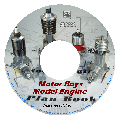
Earlier this year, our book went out of print and the AMA made a business decision not to commit to another print run. But demand continued, so we decided to apply some modern technology and produce a second edition of the book in Portable Data Format (pdf) and distribute it on Compact Disc (CD). This is an updated and uprated version, meaning all known errors have been corrected and two new plan sets have been added. Click the picture of the disc to go to the revised MBI Plan Book page where you will find more details and a link that will let you order it on-line using PayPal, Visa, or Mastercard.
But Wait! There's More...or perhaps less, depending on your perspective and understanding nature. If you are a MEN Member, you'll be better off ordering a DVD upgrade as the Plan Book is now included on the MEN DVD for the same price as the stand-alone CD version of the book. I agonized over the morality and timing of making such a significant change to the Member disc content and how Members who had just joined would feel about this. Finally, I reasoned that since the cost of Membership effectively rose from December 1st due to changing the currency used from Australian dollars to US ones, and seeing as I'd given clear warning of this pending rise, most Members joining up in November did so at a discount greater than the update price. I really can't release the CD version of the Book as part of the regular Members' Monthly Update Download, it's just too big for this to be practical—sorry, truly I am. But even if you now order an update to get the MBI Book, you are still ahead. Seems a bit thin, but I think it's fair and sure hope November Members do too.
Members' Free December Plan
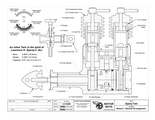
What to present to Members for the traditional end of year free plan was a bit of a delema as I wanted a type different from all the others released so far. We have a small diesel, small glow, a sparkie, a steam engine, a fixed compression "diesel", and a replica, so what next? The answer is obvious, Dear Watson; a Twin! So Members who can remember their username and password, log into the secure Members' Section and grab your copy of an engine that Ken Croft and I collaborated over about eight years back. It's an in-line, alternate-firing, twin diesel in the tradition of Lawrence H Sparey, meaning it looks distinctly like his 0.63cc diesel that's grown an extra head, but is certainly nothing he ever had anything to do with. The bore has been increased to provide 1cc per cylinder and an extra cylinder sheet provides a slightly less stove-pipe look if you think the original looks a tad tall (shorter piston means less running friction too). Builders out there, be sure to send photos!
Moteurs MA Update
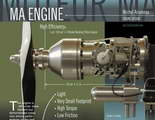
Remember our Canadian friend, Michel Arseneau, designer of the cam-activated piston engine, and master of IC engine CAD/CAM machining? Michel emailed to say his Moteurs MA website has had a major update. As well as more information on his existing designs, the site gives a sneak preview of a new engine development, details of which are still under wraps. Like Michel's other designs, it features a low frontal profile that makes you wonder, given that it is not a turbine, what can possibly be inside? Well, as they say, stay tuned; Michel has just been granted a World Wide Patent on the new technology and we hope to present news of how it works first in these pages, early in the new year. In the mean time, be sure to click the thumbnail or click the Moteurs MA link to visit the website. You can also find this link on the MEN Links page.
R-1830
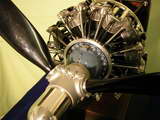
Ron Harris (England) has his R-1830 fully assembled now, complete with the electrically controlled three blade prop fitted with scale Bolly blades, just like you'd see poking out of the nacelles of a DC3. If the sight of it does not make you look twice and think "if only...", you are reading the wrong sort of web page! The engine has not had its shake-down yet, but this is no static model. For those who want their own, visit the new Bruce Satra R-1830 page where you'll find prices of the special castings available from Vernal Engineering, plus contact details for obtaining the Bob Roach plan set, and various CNC machined components that will make life much easier (do you really want to machine 28 little stainless steel poppet valves, plus a spare or two, by hand?)
Almost Right
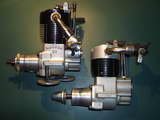
Well, we almost got last month's watzit right. Showing just how widely and avidly each MEN issue is read, the full and correct answer arrived from Switzerland within a week of the page being released. It also appears that some readers may have missed the grand new feature that provides a "click this button to see the hidden answer", or possibly my testing has not been extensive enough and the feature is not working on all web browsers. Anyway, go have another look at Marinated 4-stroke and look for a new, enlarged button at the end of the section. Click this and hidden text and photos _should_ appear. If this does not work for you, please email us with details of the web browser type, version, computer operating system, mother's maiden name, and anything else you can think of. It would be nice to know if this gizmo works for everyone, and if not, why not!
Magazine Index Spreadsheet
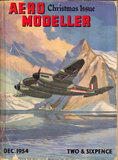
I've lost count of the occasions that the Model Engineer magazine index spreadsheets have been used to chase down information for these pages. These are freely available as downloads (see the Links Page) and go way, way back. This is a gigantic undertaking, but someone did it and my hat is off to them. Now "someone" is doing the same thing for the venerable old Aeromodeller, another resource I rely heavily on to chase down facts and dates. The work is a collaboration with time being donated by people all over and coordinated by Colin Usher Appleton (UK). Colin's website provides details and guidelines for those willing to help, and contains other truly useful resources as well.
As a bit of an historical note, some years back, I became involved with a group dedicated to creating a complete set of the works of fantasy, crime, and science fiction writer, Jack Vance. After a lot of effort by a lot of people, this resulted in the Vance Integral Edition (VIE), a full hardbound set of which now sits on two shelves of The Library. The effort was undertaken with the help of the author himself (now in his 90's) and his tireless wife, Norma. As Jack wrote mostly before the age of the word processor, this involved double digitization and OCR (optical character recognition) of a "reference" version of each book, or short story, followed by a battery of processes to first sanitize the OCR text to match the reference source, then restore it to as close as possible to the spelling and punctuation used in Jack's original manuscripts. The last step was required because we know from Jack and Norma that countless pulp magazine editors had "corrected" the submitted manuscripts. The Internet made the project possible and the volunteers made it happen. Although somewhat different in scope and approach, Colin's initiative to create a comprehensive index for the Aeromodeller and other magazines is similar and practical only because of the Internet. So if you are prepared to help him, you'll be helping many others too, including me—I want that Index!
New Books and Magazines This Month

Issue Number 16 of Model Engine Builder arrived last month. This is dated "March-April 2008", so Toni and Mike are still in catch-up mode. As usual, lots of good stuff for model engine builders and armchair model engineers. Jerry James, designer of the HEX series of Cox based multi-cylinder engines, provides a piece on back-yard casting that can be done indoors using ZA-12, a zinc-aluminum alloy with a low melting point that requires no degassing, is claimed to be stronger than cast iron, machines easily, and has excellent bearing properties. Given that Jerry's research is correct, why isn't everyone using this stuff?
Another article in issue 16 really caught my attention too: Cutting Skew Gears, by Alan Suttie. Alan describes a procedure he developed to cut the skew gears for his ETW Road Roller. I think there are easier and better ways to tackle this problem, but he has completed a magnificent example of the Road Roller and its four-stroke, hopper cooled spark ignition engine with reversing, variable speed gearbox, so he clearly out-ranks me! His method involves building a pair of rather complex jigs to a high degree of precision. These act as indexable fixtures which when gripped eccentrically in the lathe 4-jaw chuck, allow each tooth to be turned by a simple form tool. The result is a set of teeth which he admits are not quite right, but are certainly close enough. My own method, developed for the Feeney four-stroke used an ordinary indexing rotary table and a shop-made "hob" type cutter for the vertical mill. The teeth cut this way are a faceted approximation of a true involute, so are not quite correct either, although they make sliding rather than point contact. But then again, they are certainly close enough for government work, and closer to correct that those produced by eccentric turning. But model engineering is all about solving problems and finding techniques that work for you. Alan's technique works for him and I'll bet he got a great deal of satisfaction from solving the problem in a unique way. I may disagree with the approach, but I enjoyed reading about it, and positively love his ETW Road Roller!
Other articles and plans include the conclusion to Brian Fairey's VAL four-stroke (a very attractive and well thought out design, Brian), and Yet Another way of making expanding cylinder laps using a tapered mandrel. I have tried this several years back and concluded that it is a lot of effort to produce results that can be achieved with simpler tooling. On the plus side, it does provide better control over bore taper. Another case of "whatever works for you"; there is never only one true solution and the more ideas you read, the better equipped you will be when it comes time to solve unusual problems of your own.
Engine Of The Month: FROG 349
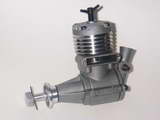
Odd how one thing leads to another; serendipity, some call it. While laying out the text for Part 2 of Gordon Cornell's Model Engine Development series, I added a link to a photo of an engine he mentioned in his text. During the process we have evolved to transform the original "book form" text better suit presentation as a web resource, Gordon reviews what I've done to his work several times before they are permitted to "go live" as it were. During an early draft of Part 2, he emailed saying he'd hoped I could include the published review of the engine, not just a picture. Always a sucker for punishment, I figured a genuine MEN type review which included the old magazine reviews would be even better, so I timidly asked Adrian Duncan if he had a FROG 349 and could do a small, quickie review? His immediate response was the (one), yes he had several of them, and (two) it was just about his favorite engine, and (three), yes again, he could do one of his reviews for the December issue, but (four), small!! For Adrian's favorite engine, no way, Jose!! So click the pic, look in the Finder, or follow this link to the FROG 349 page for all you ever wanted to know and didn't even know you needed to ask...
Product Review: ICE Version 1.7
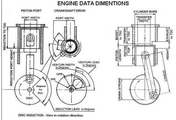
ICE is a software tool designed by Gordon Cornell for use by Students, Engineers etc to evaluate and illustrate the potential performance of two-stroke Internal Combustion Engines. It is available for £25 (excluding shipping) only from the author and you should contact him for prices on available shipping options. Although I bought an early copy of the program, I took the easy way out and instead of reviewing it, simply referenced a review the appeared in Issue 109 of Model Engineers' Workshop". While corresponding with Gordon during the initial stages of laying out his Model Engine Design series, he told me that the revision reviewed by MEW was now rather old and many of the findings were no longer valid. So Gordon asked if MEN would give the latest version a test drive. This turns out to be a big job because ICE is what we call a "non-trivial" utility. So click the thumbnail pic to read my evaluation, so far.
Tech Tip of the Month
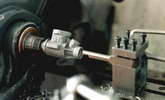
This month's tip actually came from a footnote in Gordon Cornell's Model Engine Development series. As you will read in Part 2, Gordon has evolved a way of machining the pockets for the ball races to ensure the correct degree of press-fit and accurate, concentric alignment is achieved by taking advantage of the fact that the crankcase for the modern replica is not a casting. It turns out that this is easier than would be the case if the case was a casting. For the latter, the job requires some special jigging and as Gordon supplied a photo of the fixture typically used to machine die cast crankcases with a screw-in backplate for the ball race pockets, I though it would be worth while detailing this as a How-To in our expanding series of tip pages. So click the thumbnail picture, or follow the link to the How To Machine Crankcases for Ball-races page.
Engine Animation on YouTube
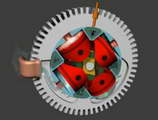
I've no idea how long this one will stay available on YouTube, so go look now. It is a CAD 3D animation of Jerry Hale's rotary showing the internal movements. You should recall that this engine appeared as the centerfold in MEB, issue before last. The creator (artist? draftsman?) of the animation is John Downie who is no stranger to this sort of work, as you'll see from the other offering he has on YouTube, and the CAD 3D models such as the Whittle Aero V8 which have graced these pages before. The YouTube URL is http://uk.youtube.com/watch?v=6JaJ6T0T1sk and at the time I visited, that link will also give pictures of the actual Hale Rotary in action, as well as an animation by John of the Whittle V8 mentioned above being "assembled", so knock yourself out and burn up some bandwidth enjoying the show(s).
 Nemett on the Web
Nemett on the Web
 Ascot '08
Ascot '08
 Model Engine Development Part 2
Model Engine Development Part 2
 MBI Plan Book, Second Edition
MBI Plan Book, Second Edition
 Members' Free December Plan
Members' Free December Plan
 Moteurs MA Update
Moteurs MA Update
 R-1830
R-1830
 Almost Right
Almost Right
 Magazine Index Spreadsheet
Magazine Index Spreadsheet
 Engine Animation on U-Tube
Engine Animation on U-Tube
 Editorial
Editorial
 New Books and Magazines This Month
New Books and Magazines This Month
 Engine Of The Month: FROG 349
Engine Of The Month: FROG 349
 Product Review: ICE Version 1.7
Product Review: ICE Version 1.7
 Tech Tip of the Month
Tech Tip of the Month
 Standard Stuff
Standard Stuff



 I hope you enjoy the December issue. Somehow it turned into quite a monster. As well as Part 2 of Gordon Cornell's engine development series, we have a long Adrian Duncan engine review, and the traditional December Free Plan set in the Members Download section. Also, as promised last month, there is the review of ICE version 1.7, Gordon's tool used to assist engine development. Add to that a show picture montage, some actual news, release of the second edition of the plan book, and updates to various older pages (see the Update Index in the Site Map menu). Sincere thanks go to all who joined the Members ranks last month and best wishes to everybody for the holiday season. See you next year...
I hope you enjoy the December issue. Somehow it turned into quite a monster. As well as Part 2 of Gordon Cornell's engine development series, we have a long Adrian Duncan engine review, and the traditional December Free Plan set in the Members Download section. Also, as promised last month, there is the review of ICE version 1.7, Gordon's tool used to assist engine development. Add to that a show picture montage, some actual news, release of the second edition of the plan book, and updates to various older pages (see the Update Index in the Site Map menu). Sincere thanks go to all who joined the Members ranks last month and best wishes to everybody for the holiday season. See you next year...

 . The magazines operated under separate editors from that time until just recently when David Clark was appointed editor for both ME and MEW. This means that some changes are in the wind and we will have to wait and see how this impacts the IC content dear to our hearts. British magazines are ruinously expensive "downunder" and should the IC content of the ME drop, I'll drop my subscription with a positive sigh of relief.
. The magazines operated under separate editors from that time until just recently when David Clark was appointed editor for both ME and MEW. This means that some changes are in the wind and we will have to wait and see how this impacts the IC content dear to our hearts. British magazines are ruinously expensive "downunder" and should the IC content of the ME drop, I'll drop my subscription with a positive sigh of relief.












